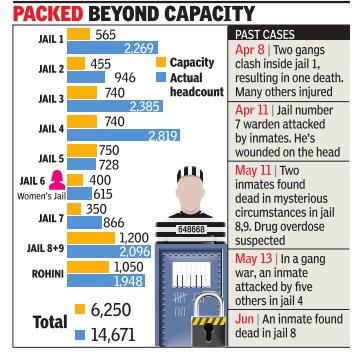Delhi: Tihar jail

This is a collection of articles archived for the excellence of their content. Readers will be able to edit existing articles and post new articles directly |
Contents |
Tihar gallows wood in demand as lucky charm
Megha Suri Singh
New Delhi: The gallows at the high-security Tihar Jail have been made out of bounds for prisoners and jail staff alike. The move has nothing to do with security concerns in the wake of increasing pressure on the government to carry out the death sentence of Parliament attack accused Mohammad Afzal Guru, who is lodged in the jail. It’s actually to protect the gallows from people desperately seeking small pieces of its wood.
Over the years, a belief has spread that the wood which forms the gallows brings good luck. It supposedly assures good results for children if kept in school books and wards off fears of all kind when kept under the pillow while sleeping. People even try to scrape off pieces of the wood and wear it on their arm as a talisman.
‘‘The top layer of wood on the gallows was fast disappearing as people have chipped off pieces. So a few years ago, we decided to keep the area locked. But requests for the wood continue to come from all sections of society including judges, politicians, bureaucrats and even jail staff,’’ said a prison official. So now, only the influential manage to get that lucky piece of wood. With 11 inmates facing a death sentence, including Guru, the gallows are refurbished from time to time. This includes checking the wood and if need be, replacing it, oiling the levers and testing the apparatus.
Gallows at Tihar Jail ready for execution
New Delhi: The last death sentence carried out at Tihar was way back in 1989 when the killers of late Prime Minister Indira Gandhi — Satwant Singh and Kehar Singh — were hanged. With the debate on the execution of Mohammad Afzal Guru’s death sentence hotting up, the gallows could soon be put to use. But is Tihar ready to carry out an execution?
‘‘After a mercy petition of a convict is rejected by the President, we have to approach the sessions judge who awards the death sentence, for a black warrant. This specifies an exact date and time for execution, which is within one week of the petition being rejected. That much time is enough for us to prepare,’’ said Sunil Kumar Gupta, law officer, Delhi prisons. As for the apparatus, the prison administration procured a special wax-coated rope manufactured only in Buxar Jail, soon after the apex court upheld Afzal’s death sentence in 2006. The rope used for hanging weighs 3.75kg and is 16 feet long.
In 2005, the gallows located in the compound of Jail 3 were refurbished. The wooden panels and planks were given a makeover in metal and the noose handle was greased to get it back in working condition after 15 years.
Since then, regular maintenance is reportedly being carried out.
Education
Continuing education behind bars
As in 2021
Shradha Chettri, February 18, 2021: The Times of India

From: Shradha Chettri, February 18, 2021: The Times of India
A prison may not jump to mind when you think of the pursuit of education. But Tihar jail has many inmates who are undertaking courses from Indira Gandhi National Open University, including master’s degree in public administration, postgraduate diploma in business operations, bachelor’s degree in social work and certificate in food and nutrition.
An RTI filed by law student Aniket Gaurav elicited these details of courses being pursued by Tihar inmates for the past five years. Most students are enrolled in certificate and diploma courses. A large number, of course, are undertaking Class X and XII courses. There are many incarcerated students enrolled in bachelor’s degree courses.
Gaurav filed the RTI after learning that exams for the inmates hadn’t been held last year due to the Covid-19 pandemic. “While everyone outside was talking about conducting exams, no one was concerned about the jail inmates. The overall data shows the proportion of students undertaking courses among the prison inmates is very low,” said Gaurav.
Sandeep Goel, DG, Tihar Jail, responded, “The exams are under way now. While NIOS conducted exams two weeks ago, Ignou is holding them now.”
With the caveat that some of the jails did not provide details for the RTI response, the most popular course in most jails is the bachelor’s preparatory programme offered by Ignou. In Jail No 13 in 2017, 69 students were enrolled, the highest for any course in the central prison. In 2020, around five inmates there were undertaking the course.
As for diploma courses, at Jail No 13 in Mandoli, in 2020, 48 inmates are enrolled in the certificate course in food and nutrition. In 2017, 39 students had taken up the course. At Jail No 6, around seven students had passed the same course.
The postgraduate diploma in business operations attracts students too. In Tihar’s Jail No 3, three completed the course in the 2018-19 academic session. Since 2015-16, two or three students have regularly undertaken this course, and a total of 32 students completed the graduation programme and 19, the postgraduate programme between 2014-15 and 2018-19.
However, in Jail No 16 and 15, no one has passed any course in the last five years. There are also students enrolled in classes X and XII. In Class X, NIOS has 318 aspirants and 48 in Class XII. Ignou has overall 370 enrolled.
High suicide rate

In Sept 2014, Delhi's Tihar jail, one of the world's largest prison complexes, saw four deaths of inmates. Data shows that the suicide rate (incidents per lakh of population) is much higher among prison inmates than in the general population. Data also shows that in 2012, the inmate suicide rate was more than double the national average. The murder rate inside prisons is also rising steadily and is now higher than the national rate. The overall death rate (deaths per 1,000 population) is, however, lower in prison than outside. With over 85% of inmates aged 18-50, an age group with a low death rate, that's not surprising.
Jail 8
2015: Jan to Aug

The Times of India, Aug 13 2015
Anvit Srivastava
Jail 8 has seen 4 assaults in 2015
The killing of an undertrial in Tihar Jail on August 11, 2015 has raised serious questions on the security system inside its prisons. This is the fourth such incident reported from Tihar's jail number eight in 2015. The jail, which has a capacity of 600 inmates, is overcrowded with 1,033 inmates. Of these, 888 are undertrials and 145 are convicts. Officials say that jail number eight is one of the major trouble spots in the complex and keeps the administration on its toes.
In March, a Nigerian was reportedly found dead under mysterious circumstances in the same jail. The police had suspected it to be a case of drug overdose or poisoning. Two months later in May , two inmates, Ritesh Mittal (32) and Amit (26), were also found dead in jail number eight in a similar manner. It was said that the duo died after consuming drugs which were illegally smuggled into the jail.Another inmate, Prithvi (32), died in June in the same jail and no particular cause of death could be established.
In September 2014, an inmate was found hanging in the toilet of jail number eight which was suspected to be a case of suicide.
Sources also say as about half of the population of the jail is young and have committed heinous crimes, clashes have become a daily affair.
Smuggling in prohibited items
2018

From: Sidharth Bhardwaj, From cellphones to charas, Tihar prisoners get them all, January 13, 2019: The Times of India
2018 Data Show There Is Nothing That Isn’t Smuggled In
Prisoners in Tihar Central Jail don’t have access to certain items. At least that’s what you think. But the 3rd Battalion of Delhi Armed Police, tasked with escorting under-trial prisoners and convicts to and from the prison, has a different story. Sharing data about items confiscated from the inmates in 2018, the officials revealed how they recovered banned articles, including cash, blades, knives, mobile phones, even narcotic substances.
The 3rd Battalion cops accompany the prisoners to courts in and outside Delhi and back and to hospitals. They usually take custody of the prisoners a night before the day they are to leave the jail and conduct a round of checking at that time, followed by frisking when leaving the complex. The 2018 data showed that the 3rd Battalion escorted 2,97,420 prisoners of various categories for production before courts, while accompanying 655 under-trial prisoners to their custody and parole hearings.
Delhi Armed Police disclosed on Saturday that its personnel had recovered Rs 76,810 in cash from prisoners during security checks conducted before and after their trip from the jail. They also discovered around 100 mobile phones and watches hidden in body cavities and clothing. The teams also recovered more than 1,000 pouches of tobacco products and sharpened metal strips that could be used as weapons to attack other inmates or jail officials.
In 2017, the cops had recovered Rs 61,510 cash and one metal strip, along with 700 pouches of tobacco products. Sources attributed the rise in seizures mainly to the increase in the number of prisoners. While the cops earlier escorted around 1,500 prisoners a day, the average went up to 1,900 in 2018, with some days seeing as many as 2,300 prisoners on the move.
“There is a shortage of manpower and relatives of prisoners take advantage of the crowded court corridors to smuggle in contraband to them,” a third battalion cop shared. Other cops disclosed that prisoners often clandestinely bring back surgical blades and other implements from hospitals when they are taken for medical check-ups or for specific treatments.
In May last year, an inquiry was launched when a cache of cell phones, perfume bottles, imported chocolates and 73 packets of ready-to-eat food items were recovered from an SUV parked inside Tihar Jail’s compound. Over all, in 2018, more than 200 mobile phones were recovered from the three jail complexes, according to the official Delhi Armed Police data.